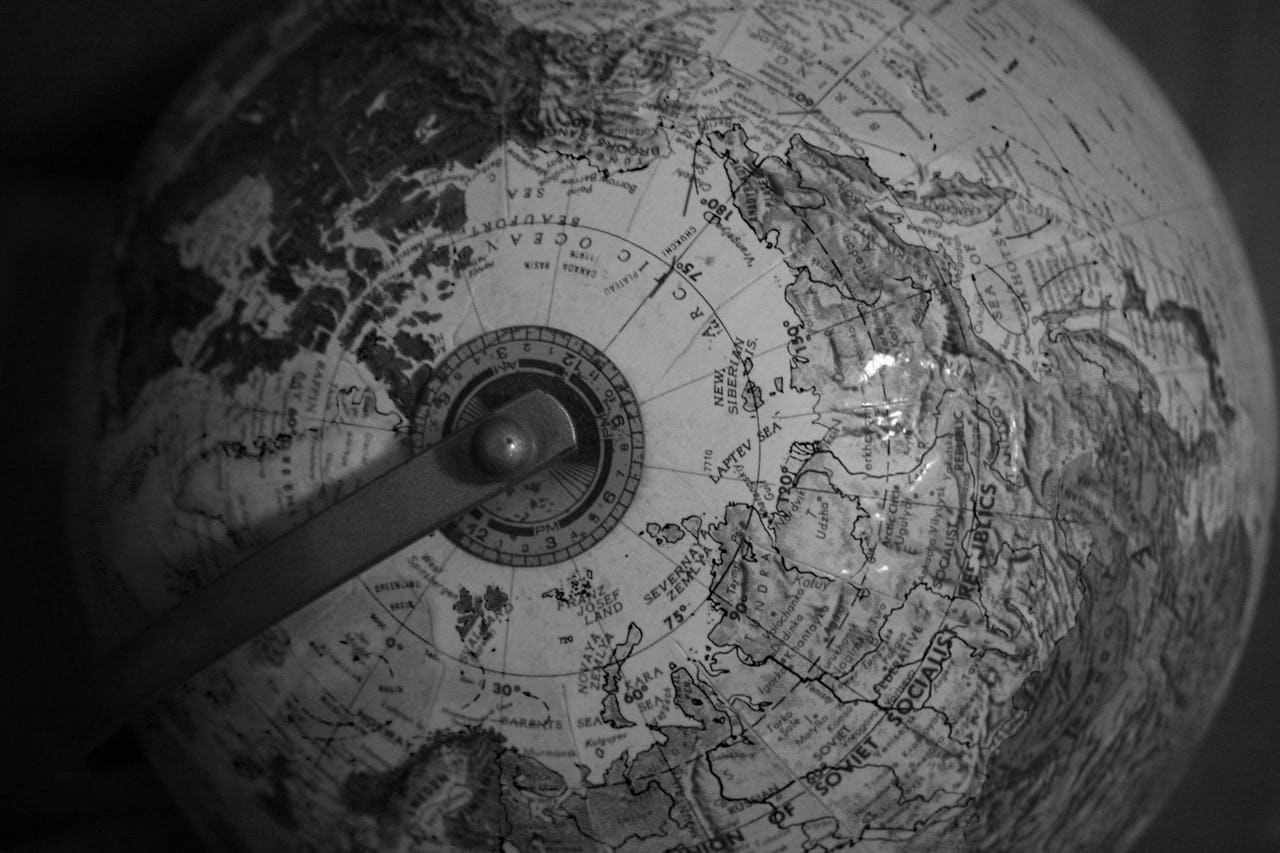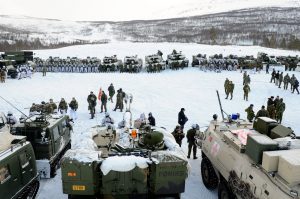The Arctic Council: Underpinning Stability in the Arctic

The Arctic as part of the entire globe. Photo: Courtney Weaver
At first glance, it may seem odd that a once-obscure organization devoted to environmental preservation and sustainable development should now be among the Arctic’s most prominent actors. To experienced observers, however, the Arctic Council’s growing stature is no more surprising than the fact that the regional ‘meltdown’ many political scientists forecast has never occurred. Today, the council is effectively presiding over an emerging ‘stability architecture’ based not on military strength, but on the multilateral pursuit of common interests. This does not imply the exclusion of the military, simply its deployment in novel and unconventional ways. This article looks back briefly on the crisis that never was, before scanning the current Arctic security horizon and evaluating the developing role of the Arctic Council.
Except in the minds of a few headline writers perhaps, none of the semi-apocalyptic conflict scenarios envisaged for the Arctic has developed. Instead, the eight Arctic states – Canada, Russia, Norway, Sweden, Finland, Denmark, Iceland and the US – have established ever-closer relations. Certainly, Norway and Denmark have modernised their surface fleets and Russia has bolstered its shrunken postCold War capabilities, but the region has not been militarised. Boundary tiffs have never flared into open conflict: they have either been settled, in the case of the Russo-Norwegian Barents Sea dispute, or allowed to fall dormant once again, as in the case of Hans Island. The rush for energy resources never occurred either: companies have secured licences and, in some cases, drilled exploratory wells, but their behaviour has been cautious.
The one thing the alarmists were correct about was the magnitude of the changes the Arctic environment would experience. In fact, they underestimated it. The average annual temperature in the Arctic is rising faster than predicted and the rate of ice-melt is accelerating similarly, with global sea levels projected to rise by a metre by 2100. Unusual weather patterns across Europe are lending weight to warnings that these and other developments could contribute, by altering the path of the jet stream, to more frequent extreme weather across the hemisphere.
The wrong conclusion to draw would be that if the current effects of climate change have not yet triggered a resource ‘scramble’ or drawn countries into confrontation, the Arctic can be written off as a key strategic theatre. On the contrary, foreign and defence ministries across the region – and beyond – are more focused on it than ever.
The trends they are watching – drifting fish stocks, increasing shipping and expanding hydrocarbon exploration – are not conventional military concerns. Indeed, they are overwhelmingly civilian, but their unifying theme is growing human activity, and thus unpredictability. The armed forces, beyond their responsibility for handling all contingencies, are also the only agencies with both the requisite monitoring instruments and the physical capabilities to operate in such a vast and inhospitable region. Canada, for instance, must treat potential search and rescue (SAR) missions as expeditionary: its armed forces are experimenting with a ‘hub’ concept that involves prepositioning equipment in depots across the north to lengthen their reach and shorten their reaction time.

It is no surprise, therefore, that the ‘Arctic militaries’ are increasingly working together. Annual joint exercises help them to develop the necessary skills and co-ordination: Exercise Cold Response 2012 – held in Norway last March and simulating action under NATO leadership – involved over 16,000 personnel from a dozen countries.
New partnership structures are gradually emerging, too. One is the Arctic Security Forces Roundtable (ASFR), a semi-annual gathering of senior military officers from the Arctic Eight and selected allies, which looks at how to improve co-operation, particularly in terms of SAR and domain awareness. Highly informal at present, the ASFR could gradually develop into a more structured forum for international co-ordination.
Nonetheless, reasoning that the regional security architecture needs revamping to accommodate the Arctic’s transformation is probably going too far. For one, attempts to ‘secure’ the region could well achieve the opposite. For example, as Canadian Prime Minister Stephen Harper told Anders Fogh Rasmussen, NATO’s secretary-general, in 2010, a NATO presence would only antagonise Russia.
Moreover, hard power frameworks are not the only way to maintain peace. In the Arctic, the coastal states’ reverence for the existing international legal regime is a crucial part of the region’s stability. Another part is these states’ common belief in the economic benefits that stability brings. With international law as the basic foundation, and economic profit (balanced with environmental custodianship) as the organising principle, therefore, the most effective ‘security’ architecture may develop out of the aggregation of government policies geared towards facilitating and regulating healthy commercial activity. The result would be less a security than a stability architecture.
It therefore seems fitting that the Arctic Council, whose key characteristic is its sustained refusal to consider matters touching on ‘hard’ security, should now be considered the central actor on the region’s political stage. Formed in 1996 to promote co-operation and interaction among its members, predominantly in relation to environmental protection and sustainable development, the council has a number of unique features. One is the status it accords indigenous groups: in their position as ‘Permanent Participants’, these groups are able to work on unusually even terms with governments and shape the council’s research agenda.
Another is the council’s lack of decision-making power: it is a forum, or clearing-house, for Arctic research, not an executive organisation. Its output – like the 2009 Arctic Marine Shipping Assessment – is meant to provide not just its member states, but all relevant stakeholders in the international community, with reliable data and analysis. Nevertheless, because the resulting reports tend to be exhaustive and draw on expertise from around the world, the recommendations produced carry considerable weight.
This quiet authority, coupled with the 2011 signing of a binding SAR agreement and the current elaboration of an oil-spill prevention protocol, has prompted suggestions that the organisation is changing. But this is only partly right: the SAR agreement, although negotiated ‘under the auspices’ of the Arctic Council, was not in fact a product of the council itself but of its eight permanent members. The same will apply to the oil-spill prevention document.
What is true is that the ‘dual identity’ of the Arctic Eight as both council members and ‘free-standing’ states gives the council an executive aura, particularly when they – or even just the five states with Arctic coastlines – sign agreements regulating their own behaviour. A good illustration is the Ilulissat Declaration of 2008, in which the ‘Arctic Five’ pledged to resolve any jurisdictional disagreements between them peacefully, and pointedly affirmed that the United Nations Convention on the Law of the Sea (UNCLOS) obviated the need for new regional governance structures. (Admittedly, this announcement also created the impression that the three non-coastal states had been excluded.)
Such statements have both shielded the council from overt politicisation and implied that the political heart of the region beats within it. There could thus be said to be a symbiotic dynamic at work here. On the one hand, the ‘executive’ power of the member states is projected onto the Arctic Council. On the other, the legitimating power of the council, largely derived from the centrality of the Permanent Participants and the presence of observers, imbues the Arctic Eight with additional authority.
This legitimacy-cum-authority helps explain why fourteen different countries and organisations wish to be admitted as observers this May. Whatever the eventual decision on these applications, the demand is in itself remarkable: at least on paper, the Arctic Council requires more from observers than it offers in return. It is hard to imagine a set-up more contrary to the zero-sum logic of traditional security politics.
This deluge of applications is a golden opportunity. Openness would be a shrewd move, at a stroke enhancing the council’s legitimacy and the quality of its deliberations, and reducing the risk of being bypassed by countries acting unilaterally. Some of the council’s recent applicants could also represent a financial boon: China, South Korea, India and Japan have the fastest-growing stable of Arctic scientists, while the EU last year proposed devoting €80 billion to Arctic research.
Meanwhile, the risks of admitting new members, even heavy-hitters like China, are low. First, observers’ powers are limited: they may engage with the forum’s working groups, propose projects and state their views (all with permission), but they have no vote. Secondly, observer status does not alter international law: under UNCLOS, extra-regional actors have no jurisdiction in Arctic waters, and no applicant disputes this. Thirdly, the council is still fundamentally devoted to promoting research and knowledgesharing, and new observers could contribute greatly in this regard.
Some Permanent Participants also fear being marginalised if new observers are admitted, but the same countries could still engage bilaterally with Arctic states from outside of the council, and there is no difference in power between permanent and ad hoc observer status. The main danger of admitting too many new observers is therefore likely to be confined to a diminished capacity for reaching swift consensus.
By all accounts, the Arctic states have not yet agreed on how to proceed with these applications. It is inconceivable that they will reject all of the applicants, but unclear how many they will approve – those garnering the most speculation being China and the EU. The Nordic countries have stated their preference for more openness than less, and look set to accept both. The US, having previously rebuked Canada for not being more inclusive, will likely go the same way.
That leaves the two Arctic giants. Despite its once-bellicose rhetoric, Canada has lately appeared sanguine. Indeed, it has just signed a free trade agreement with China and is negotiating an equivalent with the EU, so a snub would be counter-intuitive. Russia, meanwhile, is deeply distrustful of China, but China is already an ad hoc observer and security remains Russia’s main concern. Given the council’s purpose and the prescribed limits on observer status, the odds are that the balance will tip in China’s favour, just.
It can therefore be said that while security remains an important element of the Arctic strategic picture, standard definitions are unhelpful; indeed, the region’s ‘securitisation’ would be counter-productive. Stability – the end goal of security – is already present, underpinned by the heft of the Arctic Council – a forum tight enough to take influential positions but loose enough to protect the agency of its core membership.
As development intensifies and the interests of the many legitimate stakeholders – both state and nonstate – come into sharper focus, this collegial atmosphere may be challenged. Nonetheless, the Arctic is a vast space, with room enough for everyone. Do not expect great sparks to fly.
Matthew Willis is a research analyst in RUSI’s International Security Studies Department. This article was originally published in RUSI Newsbrief (Vol. 33, No. 2, March 2013) and can also be found here.